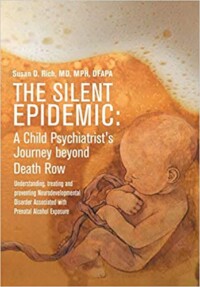Title: The Silent Epidemic: A Child Psychiatrist’s Journey beyond Death Row
Subtitle: : Understanding, Treating, and Preventing Neurodevelopmental Disorder Associated with Prenatal Alcohol Exposure
Author: Susan D. Rich, M.D., M.P.H.
Publisher: Lulu Publishing Services
Pages: 322
ISBN: 1483448819
Genre: Non-Fiction
Reviewed by: David Allen
Pacific Book Review
The Silent Epidemic is more than a judicious and brilliantly detailed exposition on a disorder: it is a wake-up call to America and the world regarding another pandemic that, absent remediation, will continue to take down hundreds of thousands of lives.
The culprit is vicious, nearly ubiquitous, almost invisible: ‘neurodevelopmental disorder-prenatal alcohol exposure (ND-PAE.)’ This mouthful of a diagnosis–loosely referred to as ‘fetal alcohol syndrome’ in the past is the vicious culprit stalking us all.
Let’s begin at the beginning. Alcohol use disorder whether it be alcohol abuse, dependence, alcoholism, a rose by any other name, may affect as many as 13.9% of the population. Babies from mothers who drink during pregnancy or nursing while still drinking are at significant risk for a variety of behavioral and physical aberrations that cause life changing detriments later in life. As children and adults, these individuals can show characteristic physical and relational deformities including delinquency, learning disorders, criminality, and violence.
Where does death row come in? We now know that many convicts on death row, convicted of capital crimes, are grown up ND-PAE babies. ND-PAE children are extra sensitive to environmental insults such as poverty, homelessness, and parental abuse; the combination of such stressors with defective hard-wiring–ND-PAE–can literally be killing. Dr. Rich and other clinicians and researchers have consistently found that significant numbers of those convicted of capital crimes are prey to their own disinhibited, ‘limited behavioral option’ brains.
These findings are grave and need to be trumpeted from the rooftops; which is exactly what this book does. Dr. Rich’s masterful book proposes a broad social program including vigorous efforts at educating at risk mothers, provision of adequate birth control to drinking mothers, and structured interventions to families with ND-PAE children.
Interestingly, this social scourge has been known about for at least two centuries. ‘Funny looking kids’ with minor physical anomalies such as low set ears and widely set eyes have been described for many generations. What is unique and ultimately valuable about Dr. Rich’s call to arms is that she is able, in the pages of this one thoughtful volume, to tie together the loose threads of observation and clinical and social commentary into a meaningful whole which is a prescription for social change and progress.
The nightmare of social and biological toxicity resulting from glib and otherwise uninformed alcohol use can end, which is another of Dr. Rich’s inspiring messages. She outlines a variety of measures and programs which could significantly reduce the social burden of alcohol-related violence, criminality, and suffering. Her book, the culmination of a lifetime’s worth of observation and study, should be required reading for policy makers, health care providers, and for all parents to be. The carefully considered arguments, tables, and explanations in this book should be supplemented by a companion volume intended for those less inclined to read monographs.


